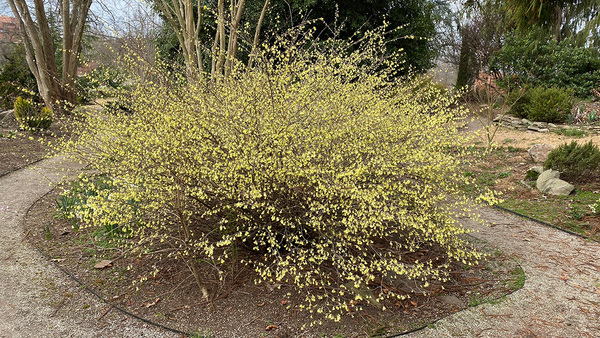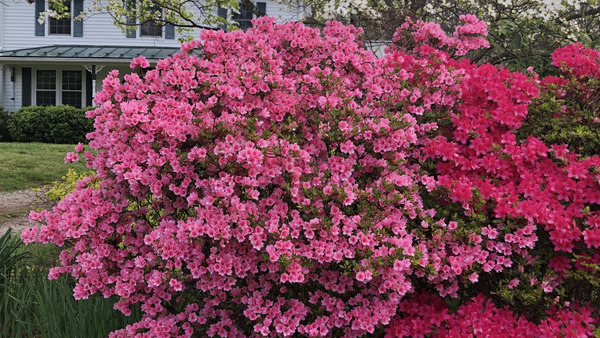
One group of plants you can use to create a blooming bridge between spring and summer are azaleas (Rhododendron spp. and cvs., Zones 3–9). As one of the most popular shrubs in the southeastern United States, they can last for generations with proper establishment and care. On the flip side, poor cultural practices can lead gardeners to disappointment. There are many types: native, nonnative, hybrids, reblooming, evergreen, and deciduous. No matter which type you choose, many of the basics for growing great azaleas stay relatively consistent.

How to plant azaleas
Learning how to properly install your new azalea will set you up for success. Before you plant, make sure your shrub is well watered. You don’t want to plant an azalea stressed from having a dry root system. This is a good tip for any shrub you are planting.
Azaleas have a fine, fibrous root system and are shallowly rooted. Not planting too deeply is imperative. I asked azalea expert Robert “Buddy” Lee about establishing azaleas in the garden. Buddy has more than 40 years of experience in nursery management, plant breeding, propagation, and new plant development, and his work includes developing the reblooming Encore group of hybrid azaleas. He told me, “When planting, it’s best to position the azalea root ball in the hole at least 2 to 3 inches above the grade of the bed. Keeping the plant positioned correctly, backfill the hole with the available soil and secure it snugly into position. Cover the top portion of the roots by mounding the soil upward and over the roots. Make sure that you do not place more than a couple of inches of soil on the top portion of the root system. Then lightly mulch the ground around the plant with no more than 2 to 3 inches of mulch.”
Mulching is an important step, as it helps control weeds, maintain moisture to the roots, and protect the roots from extreme temperature fluctuations. After planting, water the shrub well to remove air pockets and settle the plant into the soil. For more planting tips, check out 7 Mistakes to Avoid When Planting a Rhododendron.

Where to plant azaleas
The flower power of azaleas is what it’s all about. Siting plants in the most optimal location is the best way to maximize bloom. Again, I asked Buddy for his tips to get the best bloom. “Azaleas generally need about 4 to 6 hours or more per day of good sun exposure to get optimal bud formation and a denser growth habit,” he said. Look for places in your garden with high-filtered shade and lots of indirect ambient light. Avoid planting in deep shade or full blazing sun. Too much shade can cause plants to grow slightly leggier and reduce the number of flower buds. Too much sun can cause stress, and plants will require frequent irrigation.
While new plants should receive regular irrigation to help them establish, azaleas do not thrive in saturated soil. Do not plant azaleas in areas that drain slowly or consistently hold moisture. A precocious gardener can adapt these wetter areas to growing azaleas by creating berms. Using an acidic soil conditioner, build up the raised berm with good garden soil. If planted correctly and cared for appropriately, azaleas may grow well in locations that are environmentally stressful. Overall, azaleas do not like wet feet or to completely dry out. Finding this balance is important for success.
How to prune azaleas
Azaleas are best pruned right after they bloom. As always, first ask yourself, “Why do I want to prune?” Removing dead limbs and improving the overall structure of your plant should be your top reasons. If you are consistently pruning to control size, think about replacing your azalea with a different cultivar more in scale with your landscape. Now more than ever, there are hundreds of cultivars to choose from, ranging from small dwarfs that hug the ground to selections that mature to very large shrubs.
If you can’t make a switch and need to maintain a certain height, again, prune immediately after spring bloom. This pruning will encourage plants to regenerate new growth, which will grow and eventually set buds later in the season. Don’t be afraid to prune the occasional unruly branches if it helps to fit your garden’s aesthetic. Most importantly, avoid pruning as colder weather approaches. Pruning stimulates growth, and new growth will be sensitive to freezing temperatures. For more on pruning azaleas, take a look at 3 Ways to Prune Rhododendrons.

How to fertilize azaleas
It is best to fertilize azaleas in the spring after blooming has faded. Look for an acidic type of fertilizer that has been developed for acidic-soil-loving plants. In general, azaleas do not need a lot of fertilizer, so don’t overdo application. Do not fertilize azaleas during periods of drought or in a dehydrated state. Plants should be well watered before application of fertilizer. Too much fertilizer, especially fertilizer not properly spread or placed too close to your plant’s base, can burn the fibrous root system. This can lead to a weakening of the entire plant.

Picking the right azalea for your garden
If you have no azaleas in your landscape or your current plants are not thriving, I encourage you to keep researching. Many gardeners will add a variety of azaleas to their gardens to give contrast and repetition of bloom over a longer period. Additionally, there are so many types of azaleas that the recommendations given here are good but somewhat general. Because of the varying conditions throughout the Southeast, it is hard to give blanket recommendations. Different cultivars and hybrids perform differently throughout our region. Many of the new modern cultivars of azaleas are wonderful, particularly those that extend their value in the garden through rebloom. Additionally, look for old, mature specimens in your area; many of the old standby selections top my list. Look for azaleas near your hometown that knock your socks off when they are in full bloom, and find out what they are. This may be easiest at a public garden where plants are clearly labeled.
For more information on azaleas and other rhododendrons, check out:
And for more Southeast regional reports, click here.
—Andy Pulte is a faculty member in the plant sciences department at the University of Tennessee.
Photos, unless otherwise noted: Andy Pulte


















Comments
Log in or create an account to post a comment.
Sign up Log in